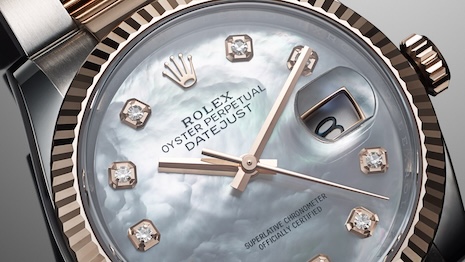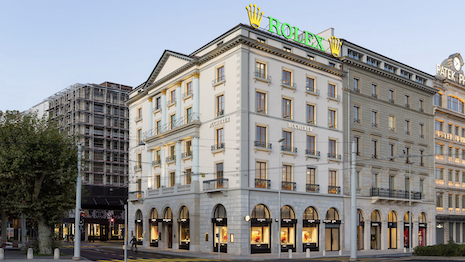 Few in the watch segment are skirting the slowdown, with many falling victim to it. Image credit: Watches of Switzerland
Few in the watch segment are skirting the slowdown, with many falling victim to it. Image credit: Watches of Switzerland
It seems that uncertainty has reigned supreme at high-end horological companies over the last six months.
While this reality was shared across luxury sectors in 2023, timepiece retailers and manufacturers such as Watches of Switzerland and Swatch Group showed early signs of economic pressure. Now, these brands are navigating unknown futures alongside peers as consolidation continues industry-wide and demand for luxury watches amid former global hot spots runs dry.
Uncertain times
As inconsistent performances define the overall luxury market in the face of the slowdown, the watch category is now in much of the same boat.
 Many maisons increased their fiscal expectations with restrictions lifting in APAC nations, a gamble that has not paid off for the majority. Image credit: Tag Heuer
Many maisons increased their fiscal expectations with restrictions lifting in APAC nations, a gamble that has not paid off for the majority. Image credit: Tag Heuer
In particular, Watches of Switzerland saw its stock price fall by 37 percent on the day of its most recent financial disclosure, according to Rapaport. Investor’s lack of confidence came following the company lowering its sales forecast for the remainder of its 2024 fiscal year, which will close at the end of April.
Now, the retailer “assumes no recovery in consumer demand” for the remainder of the period, making it monetarily stagnant year-over-year.
“The festive period was particularly volatile this year for the luxury sector, with consumers allocating spend to other categories such as fashion, beauty, hospitality and travel,” said Brian Duffy, CEO of Watches of Switzerland, in a statement.
“Whilst we are disappointed with this trend, we are encouraged by our market share gains in both the U.S. and U.K.”
Watches of Switzerland attributes the issues to U.K. consumers having a higher-than-expected interest in non-branded jewelry or lower-tier items. This is likely due to the ongoing economic uncertainty, which is causing consumers to pull back on more expensive and risky purchases to focus on what is needed, can be used as an investment or is experiential in nature.
 Despite economic challenges, some maisons are still coming out on top of the slowdown. Image credit: Richemont
Despite economic challenges, some maisons are still coming out on top of the slowdown. Image credit: Richemont
The Swatch Group, which owns luxury watchmakers such as Omega, Jacquet Droz, Longines and Tissot, also underperformed to end 2023. Its revenues are missing analyst predictions and fall well short of CEO Nick Hayek's optimistic views.
The executive expected to reach 9 billion Swiss francs in sales, or $10.4 billion at current exchange. Instead, his conglomerate saw final sales totals of 7.9 billion francs, more than 500 million francs less than the year prior.
The disappointing figures are blamed on the lack of a true rebound in the Chinese market, a trend affecting many throughout the luxury space (see story).
Despite coming up short in the third quarter of 2023, Swiss luxury conglomerate Richemont bounced back to close out the year, buoyed by strong showings in APAC, especially in mainland China (see story). While its jewelry division led the way, its watchmaking section grew by 3 percent.
French luxury conglomerate LVMH’s watches and jewelry segment posted the third highest revenues of any of its categories at the end of 2023, supporting a near double-digit percentage sales growth compared to the previous year (see story). Consumers from the APAC region were responsible for more than 30 percent of all sales.
These results line up with recent reports from global consulting firm Bain & Company and luxury brand committee Fondazione Altagamma (see story). The findings note that the high-end watch industry is thriving due to interest from Gen Z consumers, but state that this success is limited to only “luxury industry giants.”
The latter point could explain why only a few select names are seeing increased returns.
Consolidation crunch
Recent mergers and acquisitions are also to blame for the watch market getting hit by the luxury slowdown.
 Consolidation is prevalent across the new and pre-owned watch market. Image credit: Rolex
Consolidation is prevalent across the new and pre-owned watch market. Image credit: Rolex
In August 2023, Swiss watchmaker Rolex acquired European watch and jewelry retailer Bucherer (see story). The move could expand the new owner’s direct-to-consumer sales, cutting out the middleman.
Watches of Switzerland, and many other Rolex sellers, are concerned that the iconic horology label will bypass them and opt to only sell their pieces through Bucherer, a point solidified by Rapaport’s aforementioned analysis of the ongoing situation.
The pre-owned watch market has been shaken up as well, with WatchBox, Govberg Jewelers, Radcliffe Jewelers and Hyde Park Jewelers merging to form The 1916 Company in November (see story).
Secondhand timepieces’ valuations are outpacing the S&P 500 and are also often worth more than their new counterparts, due to recent releases having increased scarcity with pandemic-era supply chain holdups (see story).
With these moving parts in mind, it looks like the industry is in the midst of widespread change, but consumers appear to be in the driver's seat.